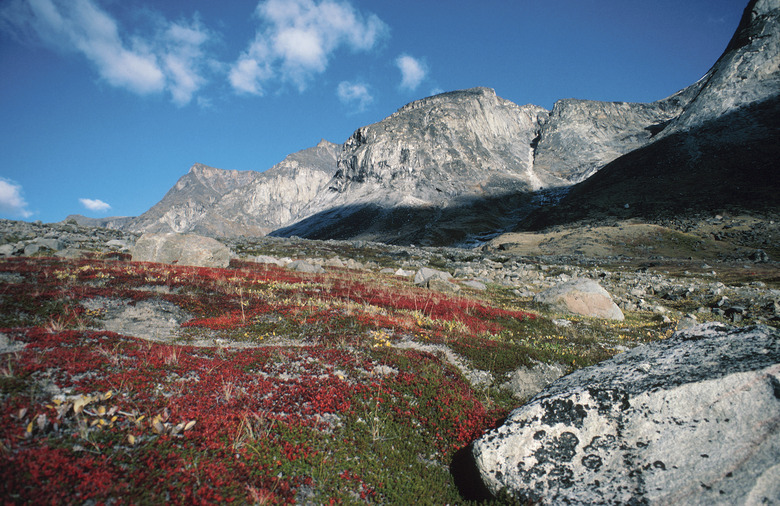The Biotic Factors For Alpine Tundra
High in the mountains, the climate is cold and windy with little precipitation. The alpine tundra biome is home to hardy plants and animals that are suited to life at high elevations.
The organisms that make up the biotic factors of alpine tundra ecosystems survive the harsh conditions with physical and behavioral adaptations.
TL;DR (Too Long; Didn't Read)
The biotic factors of the alpine tundra include low-growing hardy plants like mosses, shrubs and wildflowers and cold-adapted animals such as elk, hares, foxes, falcons and mosquitos.
Alpine Tundra Geography
Alpine
Tundra Geography
The tundra biome is found in the frozen, treeless Arctic region. Tundra biomes also exist at high elevations in lower latitudes where climate conditions are similar to the polar region. The alpine tundra shares many characteristics with the polar tundra but can be found on mountains around the world.
In the Rocky Mountains, alpine tundra begins around 11,000 feet. In the mountains of California, the alpine tundra of Mount Shasta in the Cascade Range begins around 9,000 feet, but the tundra in the Sierra Nevada Mountains farther to the south starts at around 11,500 feet.
Alpine Tundra Landscape and Climate
Alpine Tundra Landscape and Climate
Alpine tundra is characterized by rocky terrain with soil that is low in the nutrients plants need for growth, such as nitrogen and phosphorus. Alpine weather is cold, dry and windy, with most of the year's precipitation falling as snow in winter.
Conditions such as soil, landforms, sunlight, temperature and precipitation make up the abiotic, or nonliving, factors in an ecosystem. The **abiotic factors** of the alpine biome place limitations on the diversity and abundance of **biotic factors**, or living things, in an ecosystem.
Plants of the Alpine Tundra
Plants of the Alpine Tundra
The harsh growing conditions of the alpine tundra directly effect the types of plants that the ecosystem can support. Plants must be able to withstand cold temperatures and strong wind and survive with little rainfall and shallow soil.
Plants in the alpine tundra are low-growing perennials that resist breakage from high winds and freezing from low temperatures by growing close to the ground. The soil's poor nutrient quality also inhibits plant growth, which limits their size and how fast they grow.
Shrubs, grasses, mosses and herbaceous flowering plants take advantage of moisture from melting snow in spring and summer to maximize their short growing season.
Adapting to the Alpine Tundra
Adapting to the Alpine Tundra
Hardy alpine plants have adapted to life in the tundra by economizing the amount of sunlight and water needed for photosynthesis. Some plants are covered in a hair-like growth that offers protection from the cold. Growing a long taproot is another adaptation that allows some plants to seek soil and water deep below the rocky surface.
Although they are not plants, lichens are common organisms that grow on the rocky tundra and in alpine meadows. Lichens are formed from a symbiotic relationship between algae and fungi that allow them to photosynthesize and obtain water without roots.
Alpine Tundra Animals
Alpine Tundra
Animals
Animals in the alpine tundra range from insects and tiny rodents to large grazing mammals and birds of prey. Because they are consumers, their survival is tied to the success of plant populations and other producers in the ecosystem. **Primary consumers** that feed on plants include:
- elk
- caribou
- hares
- pikas
- ground squirrels
- voles
Animal Adaptations in the Tundra
Animal Adaptations in the Tundra
Alpine animals have anatomical and physiological adaptations that are suited to living in cold temperatures.
Shorter legs, tails and ears help keep heat close the center of the body and help to avoid frozen appendages. Thick fur and a layer of fat protect tissues from the cold. Insects have proteins in their cells that lower the freezing point of body fluids.
Some animals, such as bears, survive the winter by lowering their metabolic rate during **hibernation**. Birds such as hawks, falcons and sparrows migrate to warmer climates when the brief summer growing season ends. Some birds reproduce quickly during the short summer, while others wait to breed after migration.
Cite This Article
MLA
Mentzer, A.P.. "The Biotic Factors For Alpine Tundra" sciencing.com, https://www.sciencing.com/biotic-factors-alpine-tundra-10031594/. 24 June 2019.
APA
Mentzer, A.P.. (2019, June 24). The Biotic Factors For Alpine Tundra. sciencing.com. Retrieved from https://www.sciencing.com/biotic-factors-alpine-tundra-10031594/
Chicago
Mentzer, A.P.. The Biotic Factors For Alpine Tundra last modified August 30, 2022. https://www.sciencing.com/biotic-factors-alpine-tundra-10031594/
